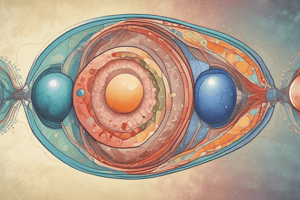Podcast
Questions and Answers
What is meiosis?
What is meiosis?
Cell division that produces reproductive cells in sexually reproducing organisms.
Which of these are stages in meiosis? (Select all that apply)
Which of these are stages in meiosis? (Select all that apply)
- Synthesis
- Prophase I (correct)
- Anaphase II (correct)
- Interphase (correct)
What occurs during meiosis I?
What occurs during meiosis I?
The first division of a two-stage process of cell division that results in cells with half the chromosome number.
What happens during meiosis II?
What happens during meiosis II?
What is interphase?
What is interphase?
What occurs during prophase I?
What occurs during prophase I?
What happens during metaphase I?
What happens during metaphase I?
What happens during anaphase I?
What happens during anaphase I?
What is telophase I?
What is telophase I?
What occurs during prophase II?
What occurs during prophase II?
What happens during metaphase II?
What happens during metaphase II?
What occurs in anaphase II?
What occurs in anaphase II?
What is telophase II?
What is telophase II?
Flashcards are hidden until you start studying
Study Notes
Meiosis Overview
- Meiosis is a type of cell division that produces reproductive cells in sexually reproducing organisms.
- It consists of two main stages: meiosis I and meiosis II, resulting in cells with half the chromosome number of the original.
Stages of Meiosis
- The entire process includes several stages: Interphase, Prophase (I and II), Metaphase (I and II), Anaphase (I and II), Telophase (I and II), and Cytokinesis.
- Interphase occurs before division when the nucleus is not actively dividing.
Meiosis I
- Meiosis I is the first phase that reduces chromosome number from diploid to haploid.
- In Prophase I, homologous chromosomes pair up and crossing over occurs, the spindle apparatus forms, and the nuclear envelope disintegrates.
- During Metaphase I, homologous pairs line up along the equator of the cell, and spindle fibers attach to their centromeres.
- Anaphase I separates homologous chromosomes which are pulled to opposite poles of the cell.
- Telophase I results in haploid cells that still contain replicated chromosomes.
Meiosis II
- Meiosis II closely resembles mitosis and occurs after meiosis I, involving the separation of sister chromatids.
- Prophase II involves the breakdown of the nuclear envelope and the formation of spindle fibers without further chromosome replication.
- In Metaphase II, sister chromatids line up at the equator, similar to metaphase in mitosis.
- Anaphase II separates sister chromatids, pulling them toward opposite poles of the cell.
- Telophase II leads to the formation of four haploid cells with distinct chromosomes, each encased in a nuclear envelope.
Studying That Suits You
Use AI to generate personalized quizzes and flashcards to suit your learning preferences.




